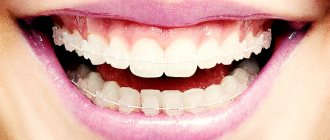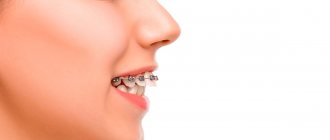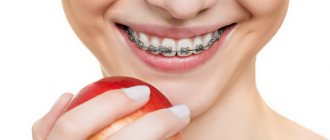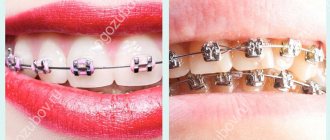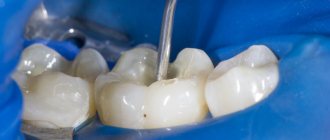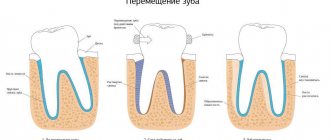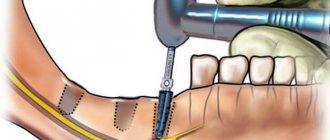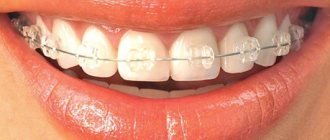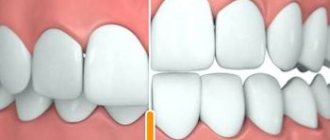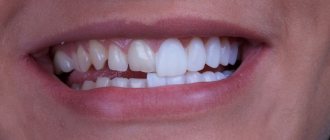Few people decide to undergo orthodontic treatment, believing that it is associated with high costs and discomfort. But often people’s fears are unfounded: installing braces is a multi-step, but safe process that goes without complications. We will tell you how orthodontic braces are placed and what stages this procedure includes.
In this article
- At what age are braces placed?
- Indications and contraindications for installing braces
- How braces are inserted: stages of orthodontic treatment
- How to install braces: diagnosis and treatment plan
- How to install braces: sanitation of the oral cavity
- Is it possible to put braces on crowns and fillings?
- How to install braces
- How to install braces: stages of the procedure
- Does it hurt to get braces?
- Braces activation
- How braces are placed on children and adults - is there a difference?
- How to care for braces
- How are braces removed?
Braces are installed primarily to correct the bite or straighten unevenly growing teeth. According to statistics, about 75% of children have problems with bite. If they are not eliminated in childhood, they will affect the health of teeth and gums in the future. In addition, people with malocclusion and irregularities in the dentition often develop complexes, lower self-esteem and, as a result, have difficulties in building interpersonal relationships.
Today, this problem can be solved in just a few years; you just need to install braces - dental brackets that are fixed to the dentition from the inside and/or outside and gradually straighten the teeth to a normal state. There are many rumors and myths surrounding the topic of orthodontic appliances.
Many people believe that getting braces is dangerous and painful, they cause discomfort, interfere with eating normally, etc. Such ideas are generated by ignorance. We'll tell you how braces are installed and how the preparation for their installation goes.
At what age are braces placed?
Braces are placed on both children and adults. Dentists say that the optimal age for orthodontic treatment with braces is 12-13 years. During this period, the final formation of the bite and the replacement of milk teeth with molars occurs. Pathologies in the structure of the dental system discovered in a teenager are eliminated faster than in adulthood.
In some cases, braces are placed earlier - at 8-11 years. However, if a person has missed this point, he can correct the problem as an adult. Of course, the treatment process will be longer, but no less effective. There is no upper age limit as such: an adult can be prescribed to wear braces as long as he has teeth, and bite correction is justified in terms of indications and contraindications.
Indications and contraindications for installing braces
Braces are placed to eliminate the following dental problems:
- malocclusion;
- uneven development of the jaws;
- anomalies of individual teeth;
- deformation of the dentition;
- chewing dysfunction;
- impacted teeth;
- large interdental spaces.
Contraindications to wearing braces can be absolute or relative. Among the first, which completely exclude the possibility of installing an orthodontic structure, are:
- absence of most of the teeth;
- some oncological pathologies;
- blood diseases;
- diseases of the endocrine system;
- very weak immunity;
- pathologies of the skeletal system;
- tuberculosis and HIV;
- psychiatric disorders.
Relative contraindications are temporary. These include:
- periodontal disease;
- caries;
- wounds in the oral cavity;
- metal implants;
- poor hygiene.
Braces can be placed only if the listed factors are eliminated. Indications and contraindications are identified during diagnosis - the first stage of installing orthodontic brackets.
Comparison of lingual and vestibular constructions
Based on their location in the dental cavity, they are divided into lingual and vestibular systems. The vestibular position on the outer side of the dentition is classic and is used in the vast majority of cases.
Vestibular Mini Diamond
Lingual appliances are installed by patients with the highest aesthetic requirements. Adaptation to internal systems is more difficult compared to vestibular structures. The principle of operation of lingual and vestibular braces is not fundamentally different: in both cases, the arch is straightened and exerts a force on the braces, leading to the movement of teeth. If there is excessive crowding, the use of a lingual system is not recommended. The duration of treatment on the lingual structure is slightly longer than on the vestibular one. The patient sometimes experiences additional discomfort due to the interaction of the tongue with the brace system.
lingual braces STb
How braces are inserted: stages of orthodontic treatment
The process of installing braces, that is, fixing them on the teeth, lasts about 1.5-2 hours. Preparation takes much more time. In general, treatment includes the following steps:
- Diagnostics: obtaining x-rays, on the basis of which braces will be made.
- Drawing up an individual treatment plan, advising the patient on preparation for the procedure.
- Sanitation of the oral cavity, treatment of diseases of the teeth and gums: caries, inflammatory processes, etc.
- Installation of an orthodontic structure, fixing it on the dentition.
- Assistance in adaptation: doctor’s recommendations regarding nutrition and care of teeth and braces during the treatment period.
Let's look at these stages in more detail.
What it is?
Braces are essentially just that part of the bracket system that is attached to the tooth, a bracket for attaching a steel arch (wire). In addition to auxiliary fittings (springs, ligatures, rings) for fixing and tensioning the wire, a bracket system is formed.
The sooner you see an orthodontist, the better, but there is no age limit for use.
The essence of braces is to correct bite defects that lead to wear and destruction of tooth enamel, the appearance of caries and a decrease in aesthetic perception:
- protruding lower or upper jaw,
- uneven overlap,
- curvature of the dentition.
How to install braces: diagnosis and treatment plan
Diagnostics allows you to identify contraindications, assess the condition of teeth and gums, take pictures and develop a further treatment plan. After the diagnostic examination, approximately a week passes, during which the doctor analyzes the material and draws up a plan for installing orthodontic structures. There may be several such plans and they differ in the method of fixing the braces or their type. The patient has the right to choose one of the proposed treatment options. Then the next stage begins - preparing the oral cavity for installation of the structure. Its duration is determined by the condition of the teeth and gums.
Removable plates
This is the “good old” classic of early orthodontic treatment. Many parents of my young patients talk about their experiences with plate therapy in childhood. Despite the long life of the plates, they do not lose their relevance, since they provide excellent treatment results, and in terms of cost they are one of the most budgetary options for orthodontic treatment.
The main component of the success of treatment is good cooperation, because the plate must be worn 24 hours a day (including school and night time). The disadvantages of the records include problems with diction and the child’s fatigue due to the duration of treatment (usually 1-1.5 years). To make the records, we use only high-quality imported materials; the child can choose any colors, sparkles and pictures so that the treatment takes place with great enthusiasm and pleasure.
Examples of excellent treatment results on plate
Before treatment
After treatment
Before treatment
After treatment
How to install braces: sanitation of the oral cavity
After installing braces, the procedure for brushing your teeth becomes noticeably more complicated and the risk of developing caries increases. To reduce it to a minimum, you need to eliminate all carious cavities. The main task of the dentist is to identify hidden foci of pathology that are located in the interdental spaces.
It is also necessary to eliminate inflammatory processes if they were detected during diagnosis. In other words, it is necessary to cure those pathologies that may become more complicated after installing braces. In addition, at the preparatory stage, ultrasonic cleaning is carried out, during which plaque and tartar are removed.
Some patients are worried that they will have to remove some teeth: “eights”, impacted ones, etc. Extraction is indicated in the following cases:
- crowded teeth;
- teeth that are too large (free-standing);
- presence of extra teeth;
- severe asymmetry of the jaws;
- decaying teeth that are useless to treat.
As a rule, if removal is necessary, it is wisdom teeth, which often erupt with complications: they grow to the sides, remain partially or completely in the gums and subsequently cause malocclusion.
Preparatory activities
Before fixing braces, it is necessary to prepare the oral cavity. For this purpose, rehabilitation is carried out. It is aimed at eliminating accumulations of plaque and stone. At the same time, existing dental diseases are treated. If any chronic pathologies are identified, they are transferred to the remission stage.
Before installing the device, be sure to treat:
- caries;
- pulpitis;
- gingivitis;
- periodontitis;
- periodontal disease;
- root cyst;
- periostitis;
- stomatitis.
If there are partially destroyed tooth crowns, they are restored in advance with composite material. If necessary, intracanal pinning and installation of artificial crowns are performed. Those units that cannot be treated are removed.
Particular attention is paid to professional oral hygiene. During this process, an ultrasonic scaler is used. This device works by performing oscillatory vibrations.
It seems to knock off hard deposits from the surface of the enamel , due to which the latter is completely cleaned and becomes absolutely smooth. This means that the upcoming fixation of braces will take place without complications. Also, after a hygiene procedure, the number of pathogens in the mouth decreases and reduces the risk of gum inflammation.
Is it possible to put braces on crowns and fillings?
Adults, even if they take excellent care of their teeth, have had caries at least once in their lives, so there are almost no patients without fillings or crowns. Their presence is not a direct contraindication to the installation of braces. Modern compounds from which fillings are made form a monolithic structure with dental tissues, so they do not fall out or collapse. They are replaced only if they were installed long ago or incorrectly.
As for crowns, they may require the installation of metal braces, which provide a more reliable and durable fixation. Thanks to this, the crown will be protected from external influences.
Biomechanics of tooth movement
To understand how braces work, let’s look at the biological and physiological processes that occur during tooth movement. The teeth are located in the alveoli - natural depressions in the jaw bones of the skull. The root of each tooth is surrounded by periodontal fibers that hold the tooth in the socket. The fibers also perform a shock-absorbing function: they allow the tooth to make micro-movements in all directions. After fixing the bracket and installing the arch, force begins to act on the root of the tooth. To move teeth slowly and less painfully, a weak and prolonged force is applied.
Due to the movement of the tooth root, there is a need to free up space in the alveolus. To do this, osteoclasts begin to destroy the bone where the root touches the alveolar wall. Osteoclasts are special cells that remove bone tissue. On the opposite side, osteoblasts produce new bone to fill the vacated space. Under the influence of osteoclasts and osteoblasts, the balance of formation and destruction of bone tissue ensures the progressive movement of teeth.
How to install braces
Braces are installed in two ways: direct and indirect. The essence of the first method is as follows: the clasps of the structure are glued onto each tooth crown using special dental cement and glue. Next, an arc is threaded through them. After fixing the braces, any remaining adhesive is removed.
When using the indirect technique, a plaster model of the patient's jaws is prepared. The dentist places locks on it, and then transfers the finished structure into the patient’s oral cavity. The entire mechanism is glued to the teeth in one go. This method can significantly reduce the procedure time - up to 30-40 minutes. This is about an hour faster than direct installation. Since the patient has to sit with the jaw expander in his mouth all this time, the difference is quite noticeable.
How to install braces: stages of the procedure
Braces can be vestibular and lingual. The former are attached to the outside of the teeth, the latter - from the inside. Regardless of what structures are installed, the procedure is carried out according to the following algorithm:
- the patient’s lips are lubricated with cosmetic Vaseline, after which a dilator is inserted into the mouth;
- saliva is removed from the oral cavity using a special tube;
- Glue is applied to the teeth, and medical cement is applied to the clasps that are attached to the enamel;
- Under the influence of an ultraviolet lamp, the cement and glue harden, as a result of which the clasps adhere to the tooth surface.
If the installation is direct, an arc is threaded through the clasps. Indirect fixation involves transferring the finished structure into the patient’s mouth. The arc has a memory effect. Gradually, she returns to the shape that was given to her during the preparation of braces and straightens her teeth.
Types of systems by fixation method
Corrective structures are fixed on the tooth surface in different ways - this is another sign for their conditional classification. Whatever material the braces are made of, they can be ligated or non-ligated. In the first case, the arch is attached to the clasps using elastic rings (ligatures). In the second option, we are talking about self-ligating systems - the arc is inserted into a special groove with a lock.
Ligature braces
The ligature system consists of a metal arch, the actual braces and connecting individual elements. The effectiveness of classical models is based on the ligature - an element of the bracket system, which is a thin metal wire.
These systems have a high degree of functionality, and in some cases, only the use of a ligature system can lead to the elimination of bite defects. If a ligature system has been chosen for treatment, then a mandatory monthly visit to the orthodontist is necessary.
Non-ligature braces
Today, manufacturers of orthodontic systems have developed self-ligating (ligature-free) braces for more comfortable treatment of patients. Due to the absence of ligatures on the locks, which are subject to deformation, visits to the orthodontist are reduced by one and a half to two times.
Externally, the self-ligating design looks neater and more attractive. The size of the locks in these systems is slightly smaller than in conventional classic systems.
In addition to the fact that non-ligature braces allow you to visit the doctor less often and look more attractive, their very effect on the teeth is softer and more gentle in comparison with ligature systems.
Removable appliances (braces)
In practical dentistry, bite correction is often carried out using removable structures. In the treatment of adults, they are not as effective as in children’s occlusion, since the complete formation of the skeletal system has already occurred.
Types of removable structures include trainers, aligners, and mouth guards.
One should not expect a radical solution to the problem of correcting the bite from such systems: they are effective only for minor curvatures or for solving the problem of jaw expansion, when the issue of lack of space for teeth arises.
Does it hurt to get braces?
Pain during the procedure can only occur if the enamel and teeth are sensitive. If necessary, the doctor will give an anesthetic injection. Once braces are in place, a person may experience discomfort, especially when chewing food. Usually he feels pressure on his jaw, but, as a rule, there is no severe pain that needs to be relieved with medication. Adaptation to braces occurs within 5-15 days, depending on the condition of the teeth.
Excursion into history
At the beginning of the 20th century, the American doctor Edward Engle created the first prototype of the braces system and called it the Engle apparatus. Angle's apparatus consisted of an elastic stainless steel arc and ligature elements. The arc was tightly fixed in the tubes. The tubes were soldered to orthodontic rings placed on the first molars. Each tooth was tied to an arch curved in the shape of the dentition with a ligature wire.
Subsequently, the scientist significantly changed the original design and developed the edgewise technique. Orthodontic locks, edgewise, were a rectangular piece with a groove. An arc was inserted into the groove and the lock was locked with a pin. Subsequently, the design of braces was modified: orthodontic arches with a square and rectangular cross-section profile, with sharp and rounded edges, appeared.
Later, the edgewise technique was further modified by doctors. Thanks to the active development of orthodontics in the 20th century, the modern operating principle of braces was formed. Today, the doctor is offered various options for torque and angulation. Torque (or inclination) is the deviation of a tooth from its axis in the vestibulo-oral direction. Angulation is the deviation of the tooth in the mesio-distal direction. Taking into account torque and angulation allows, based on a specific clinical case, to individually select the optimal brace option for each tooth.
Braces activation
Immediately after installation, the braces are activated and begin to correct the bite and irregularities. Gradually, the pressure of the arc will weaken due to the displacement of the teeth. Periodically you need to visit the orthodontist in order to tighten the structure and increase the tension. This will continue for 1-3 years until the dental problem is completely eliminated.
How to care for braces
To reduce the likelihood of developing dental diseases, the patient will have to carefully monitor their diet and oral hygiene. In particular, it is necessary to avoid hard and sticky foods, foods with dyes and smoking. If possible, you should limit your consumption of sweets. For oral care you should purchase:
- a brush with V-shaped bristles (CURAPROX Ortho);
- brush (Curaprox CPS 10, Biorepair Scovolini Interdentali Cilindrici);
- dental floss (Mirafloss implant chx);
- rinse aid with antibacterial properties (Biorepair Mouthwash).
It is advisable to use toothpastes without abrasive substances and periodically (2-3 times a week) clean the oral cavity with an irrigator. To do this, purchase devices that are suitable for caring for orthodontic structures: Little Doctor International Ltd Aquajet LD-A7, Donfeel Donfeel OR-820D Compact, Revyline RL100, Donfeel Donfeel OR-888, Panasonic EW-1411, Revyline RL 200XL, etc.
How are braces removed?
Dismantling of the structure is carried out in the dentist’s office and is carried out in several stages:
- using a special tool, the locks are unfastened;
- the arc exerting pressure is disconnected from the locks;
- each lock is removed using tweezers;
- Solvent removes remaining glue from the enamel.
To consolidate the results of treatment, the patient wears a plate for 2-3 weeks to straighten the teeth and protect them from stress. Immediately after removing braces, ultrasonic cleaning or whitening can be performed.
